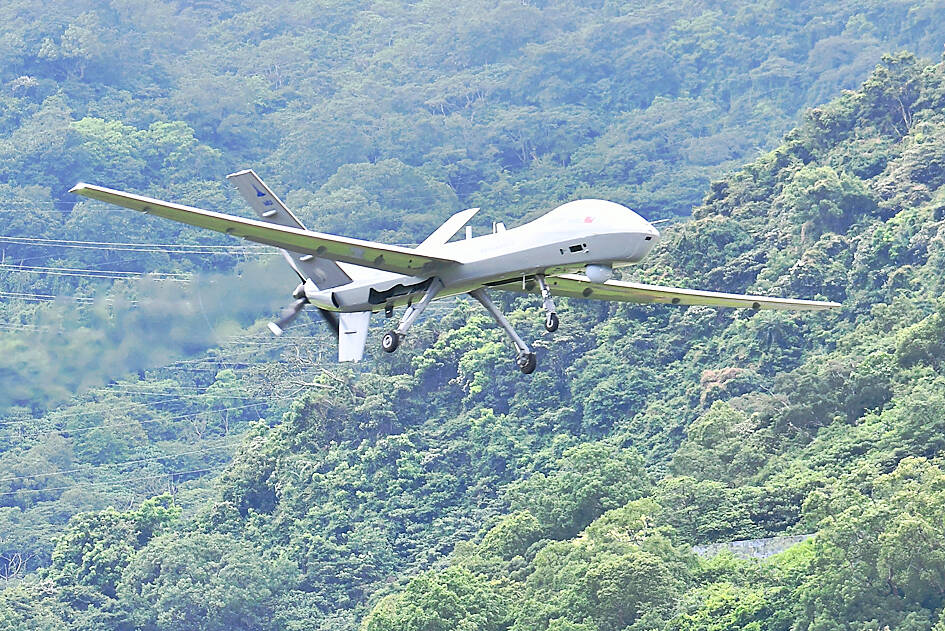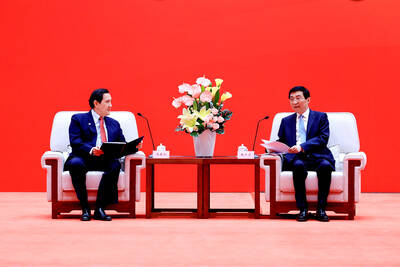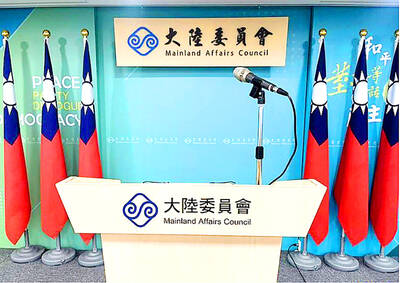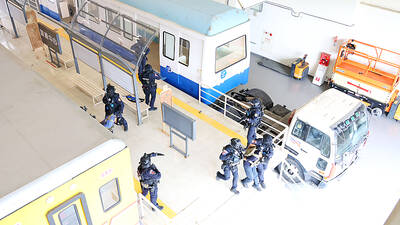The military is compiling a final evaluation report on a second-generation Teng Yun (騰雲, “Cloud Rider”) drone after tests of the self-developed uncrewed aerial vehicle were completed last month, a military source said yesterday.
Faced with the military threat from China, the military has increased research and development of drone technology as military and commercial drones have played a critical role in enabling Ukraine to deter a full-scale Russian invasion.
Aside from the 1,779 commercial drones that were built for military use through partnerships between the military and the private sector, the Chungshan Institute of Science and Technology has developed drones with military specifications, including small “cardinal” drones, medium-sized “albatross” drones, large Teng Yun drones and drones that carry loitering munitions.

Photo: Yu Tai-lang, Taipei Times
The Armaments Bureau has also developed multiaxial drones that can carry rifles and howitzers.
The first-generation Teng Yun drones did not meet the needs of the military and were not transferred to the air force, the source said.
However, the second-generation drones are equipped with a new engine, and the configuration and systems have been redesigned, the source said.
The first phase of evaluation of the second-generation Teng Yun drones was completed in mid-March 2022, and functions such as automatic takeoff and landing, as well staying in the air for nearly 24 hours, have been tested using satellite guidance and control, the source said.
Air force personnel received training to operate the drones from the institute in January and February last year, and entered combat evaluation in March of the same year, the source said.
As certain parts of the drones were identified as needing improvement during the air force combat evaluation, the software and hardware of the Teng Yun drones were updated and retested beginning in mid-March this year, the source said.
The combat evaluation was completed in the middle of last month, the source said, adding that the military is compiling the final evaluation report before entering the next phase of operations.
Although the model of the second-generation Teng Yun was unveiled at the 2019 Taipei Aerospace and Defense Technology Exhibition, public information from the institute shows that the drone’s subsystems and mounted equipment have all been developed and re-evaluated, including satellite guidance and control, electronic surveillance and synthetic aperture radar systems.
The drone also has a redundancy design for flight control and navigation, the institute said, adding that a backup mechanism would be activated if a flight fails.
Although the drone’s power system is the same as the MQ-9B drone purchased from the US military, the remaining components are mostly made in Taiwan, the institute said, adding that it would help lay the foundations for the development of domestically produced drones.

CHIP WAR: The new restrictions are expected to cut off China’s access to Taiwan’s technologies, materials and equipment essential to building AI semiconductors Taiwan has blacklisted Huawei Technologies Co (華為) and Semiconductor Manufacturing International Corp (SMIC, 中芯), dealing another major blow to the two companies spearheading China’s efforts to develop cutting-edge artificial intelligence (AI) chip technologies. The Ministry of Economic Affairs’ International Trade Administration has included Huawei, SMIC and several of their subsidiaries in an update of its so-called strategic high-tech commodities entity list, the latest version on its Web site showed on Saturday. It did not publicly announce the change. Other entities on the list include organizations such as the Taliban and al-Qaeda, as well as companies in China, Iran and elsewhere. Local companies need

CRITICISM: It is generally accepted that the Straits Forum is a CCP ‘united front’ platform, and anyone attending should maintain Taiwan’s dignity, the council said The Mainland Affairs Council (MAC) yesterday said it deeply regrets that former president Ma Ying-jeou (馬英九) echoed the Chinese Communist Party’s (CCP) “one China” principle and “united front” tactics by telling the Straits Forum that Taiwanese yearn for both sides of the Taiwan Strait to move toward “peace” and “integration.” The 17th annual Straits Forum yesterday opened in Xiamen, China, and while the Chinese Nationalist Party’s (KMT) local government heads were absent for the first time in 17 years, Ma attended the forum as “former KMT chairperson” and met with Chinese People’s Political Consultative Conference Chairman Wang Huning (王滬寧). Wang

CROSS-STRAIT: The MAC said it barred the Chinese officials from attending an event, because they failed to provide guarantees that Taiwan would be treated with respect The Mainland Affairs Council (MAC) on Friday night defended its decision to bar Chinese officials and tourism representatives from attending a tourism event in Taipei next month, citing the unsafe conditions for Taiwanese in China. The Taipei International Summer Travel Expo, organized by the Taiwan Tourism Exchange Association, is to run from July 18 to 21. China’s Taiwan Affairs Office spokeswoman Zhu Fenglian (朱鳳蓮) on Friday said that representatives from China’s travel industry were excluded from the expo. The Democratic Progressive Party government is obstructing cross-strait tourism exchange in a vain attempt to ignore the mainstream support for peaceful development

ELITE UNIT: President William Lai yesterday praised the National Police Agency’s Special Operations Group after watching it go through assault training and hostage rescue drills The US Navy regularly conducts global war games to develop deterrence strategies against a potential Chinese invasion of Taiwan, aimed at making the nation “a very difficult target to take,” US Acting Chief of Naval Operations James Kilby said on Wednesday. Testifying before the US House of Representatives Armed Services Committee, Kilby said the navy has studied the issue extensively, including routine simulations at the Naval War College. The navy is focused on five key areas: long-range strike capabilities; countering China’s command, control, communications, computers, cyber, intelligence, surveillance, reconnaissance and targeting; terminal ship defense; contested logistics; and nontraditional maritime denial tactics, Kilby